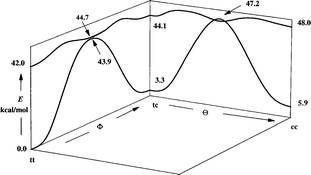Relative energies of the ground state isomers of 1,4-diphenyl-1,3-butadiene (DPB) are determined from the temperature dependence of equilibrium isomer compositions obtained with the use of diphenyl diselenide as catalyst. Temperature and concentration effects on photostationary states and isomerization quantum yields with biacetyl or fluorenone as triplet sensitizers with or without the presence of O2, lead to significant modification of the proposed DPB triplet potential energy surface. Quantum yields for ct-DPB formation from tt-DPB increase with [tt-DPB] revealing a quantum chain process in the tt → ct direction, as had been observed for the ct → tt direction, and suggesting an energy minimum at the 3ct* geometry. They confirm the presence of planar and twisted isomeric triplets in equilibrium (K), with energy transfer from planar or quasi-planar geometries (quantum chain events from tt and ct triplets) and unimolecular decay (kd) from twisted geometries. Starting from cc-DPB, ϕcc→tt increases with increasing [cc-DPB] whereas ϕcc→ct is relatively insensitive to concentration changes. The concentration and temperature dependencies of the decay rate constants of DPB triplets in cyclohexane are consistent with the mechanism deduced from the photoisomerization quantum yields. The experimental ΔH between 3tt-DPB* and 3tp-DPB*, 2.7 kcal mol−1, is compared with the calculated energy difference [DFT with B3LYP/6-31+G(d,p) basis set]. Use of the calculated ΔS = 4.04 eu between the two triplets gives kd = (2.4–6.4) × 107 s−1, close to 1.70 × 107 s−1, the value for twisted stilbene triplet decay. Experimental and calculated relative energies of DPB isomers on the ground and triplet state surfaces agree and theory is relied upon to deduce structural characteristics of the equilibrated conformers in the DPB triplet state.

You have access to this article
 Please wait while we load your content...
Something went wrong. Try again?
Please wait while we load your content...
Something went wrong. Try again?


 Please wait while we load your content...
Please wait while we load your content...